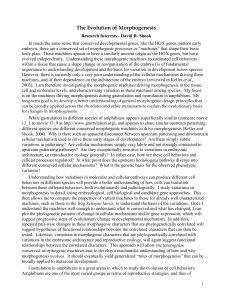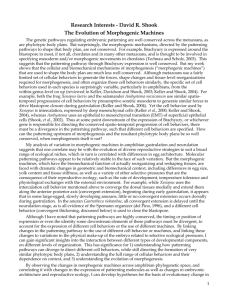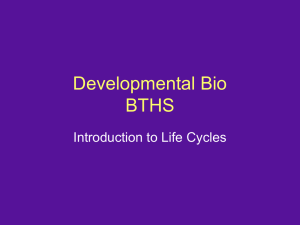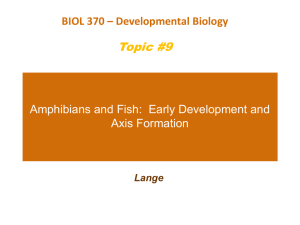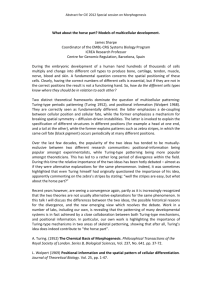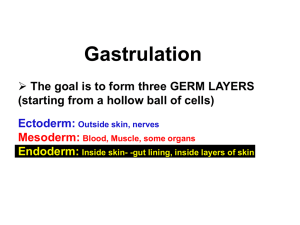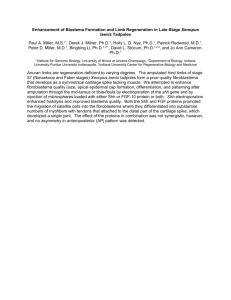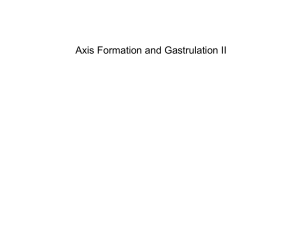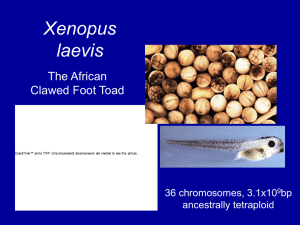Where do referees go
advertisement
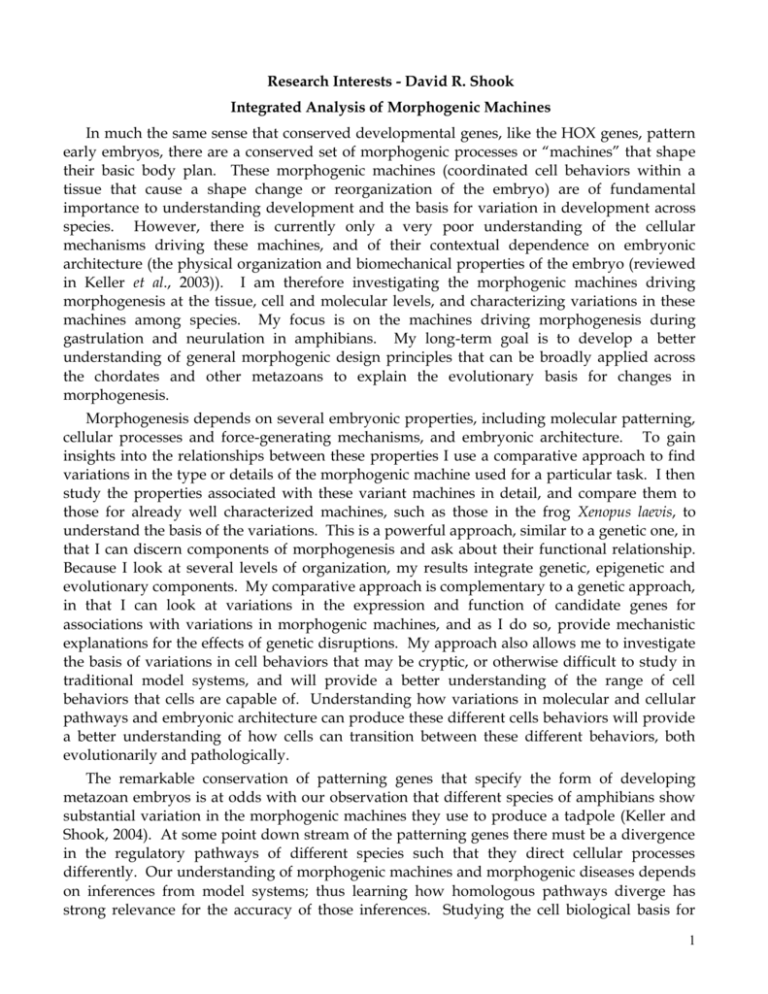
Research Interests - David R. Shook Integrated Analysis of Morphogenic Machines In much the same sense that conserved developmental genes, like the HOX genes, pattern early embryos, there are a conserved set of morphogenic processes or “machines” that shape their basic body plan. These morphogenic machines (coordinated cell behaviors within a tissue that cause a shape change or reorganization of the embryo) are of fundamental importance to understanding development and the basis for variation in development across species. However, there is currently only a very poor understanding of the cellular mechanisms driving these machines, and of their contextual dependence on embryonic architecture (the physical organization and biomechanical properties of the embryo (reviewed in Keller et al., 2003)). I am therefore investigating the morphogenic machines driving morphogenesis at the tissue, cell and molecular levels, and characterizing variations in these machines among species. My focus is on the machines driving morphogenesis during gastrulation and neurulation in amphibians. My long-term goal is to develop a better understanding of general morphogenic design principles that can be broadly applied across the chordates and other metazoans to explain the evolutionary basis for changes in morphogenesis. Morphogenesis depends on several embryonic properties, including molecular patterning, cellular processes and force-generating mechanisms, and embryonic architecture. To gain insights into the relationships between these properties I use a comparative approach to find variations in the type or details of the morphogenic machine used for a particular task. I then study the properties associated with these variant machines in detail, and compare them to those for already well characterized machines, such as those in the frog Xenopus laevis, to understand the basis of the variations. This is a powerful approach, similar to a genetic one, in that I can discern components of morphogenesis and ask about their functional relationship. Because I look at several levels of organization, my results integrate genetic, epigenetic and evolutionary components. My comparative approach is complementary to a genetic approach, in that I can look at variations in the expression and function of candidate genes for associations with variations in morphogenic machines, and as I do so, provide mechanistic explanations for the effects of genetic disruptions. My approach also allows me to investigate the basis of variations in cell behaviors that may be cryptic, or otherwise difficult to study in traditional model systems, and will provide a better understanding of the range of cell behaviors that cells are capable of. Understanding how variations in molecular and cellular pathways and embryonic architecture can produce these different cells behaviors will provide a better understanding of how cells can transition between these different behaviors, both evolutionarily and pathologically. The remarkable conservation of patterning genes that specify the form of developing metazoan embryos is at odds with our observation that different species of amphibians show substantial variation in the morphogenic machines they use to produce a tadpole (Keller and Shook, 2004). At some point down stream of the patterning genes there must be a divergence in the regulatory pathways of different species such that they direct cellular processes differently. Our understanding of morphogenic machines and morphogenic diseases depends on inferences from model systems; thus learning how homologous pathways diverge has strong relevance for the accuracy of those inferences. Studying the cell biological basis for 1 variation in diverse morphogenic machines thus has strong biomedical relevance, e.g. in terms of understanding cell behaviors like metastasis. Finding treatments for most diseases, which have complex causes involving the interaction of components over many levels of organization, will require a better understanding of such interactions, and the possible outcomes of variations in them. Gastrulation in amphibians is a great arena in which to study cell behaviors. Amphibians are one of the most varied groups in terms of reproductive strategies, and thus of embryonic architecture. This in turn is strongly correlated with variations in gastrulation mechanisms. My research focuses on variations in force producing mechanisms driving gastrulation. The large size of amphibian cells allows me to easily visualize both the localization of components within cells, as well as the behaviors and movements of the cells themselves. Visualization of cell movements and morphogenic machines is further facilitated because amphibian embryos are uniquely amenable to microsurgery and explants survive well in culture, making it easy for me to image otherwise hidden regions of the embryo (see movies 13_1 to 13_14 at http://www.gastrulation.org). I can also compare the operation of these machines in isolation by explanting tissues, or in novel contexts, by transplanting them. I can compare machines in the context of different embryonic architectures or different complements of other machines by looking at similar machines operating in different species. Looking at a morphogenic movement in different contexts allows me to discern individual machines and understand their dependence on context, to understand which machines actually produce specific morphogenic movements. The system I have developed to look at cell behaviors and force production by subduction allows me to take advantage of all these features. Current Work: I am currently investigating the cellular mechanism, biomechanics and patterning of a force producing morphogenic machine, “subduction”, that drives gastrulation in the salamander Ambystoma mexicanum. Subduction involves apical constriction, ingression and epithelial to mesenchymal transition (EMT) just inside the blastopore, adjacent to the vegetal endoderm (Shook et al., 2002). Subduction resembles primitive streak ingression in amniotes (Shook and Keller, 2003) and is very different from the mediolateral cell intercalation behavior (MIB) used by the frog, Xenopus laevis (Keller et al., 2000). In collaboration with Lance Davidson, I have developed a force measuring assay and have shown that subduction is a force producing machine. I have also shown that it is dependent on a myosin II based contraction mechanism, probably in the apical cortex of apically constricting cells, and that actin is preferentially localized to the apical cortex of cells entering the region where subduction behaviors begin. In collaboration with Bill Bement, I am using a probe for activated RhoA to visualize the activation pattern of the force producing mechanism in live explants undergoing subduction. Subduction occurs in the same spatial and temporal progression during gastrulation as MIB in Xenopus, to produce similar biomechanical forces to achieve the same morphogenic end, namely involution and blastopore closure. This suggests that I have an example of a homologous upstream patterning pathway, which somehow diverges to produce different cell behaviors. To understand both the initial patterning and the divergence of the downstream regulatory pathway, I am investigating the specification of superficial presumptive mesodermal cells to learn how and when they are directed to ingress and undergo EMT. I have demonstrated that the apical constriction and EMT associated with subduction occur progressively, beginning at one edge of the presumptive mesoderm, and appears to be pre2 patterned, as it occurs in explants with the normal time course even when portions of the tissue that would go through subduction earlier are removed (Shook et al., 2002). Whereas Ambystoma ingresses most of its large field of superficial presumptive mesoderm during gastrulation, X. laevis ingresses its few superficial presumptive mesodermal cells during neurulation (Shook et al., 2004). This delay suggests a change in the timing of mesodermal specification and differentiation, e.g. to ingress and go through EMT in these cells. To determine which genes direct these behaviors, I am testing candidates likely to be involved, based on work in Xenopus and other systems. In Xenopus, these cells express the mesodermal marker Xbra, rather than the endodermal marker Xsox17, expressed by the adjacent epithelial cells, prior to ingressing (my unpublished results). I am working to determine when mesodermal marker expression begins in the ingressing cells, and to determine the expression of the A. mexicanum homologs in subducting cells of that species. In X. laevis, the EMT regulator Xsnail appears to be expressed in the ingressing cells (Essex et al., 1993). I am therefore also looking at the expression of Snail of in cells fated to subduct in A. mexicanum, in collaboration with Dr. Marianne Bronner-Fraser. Differences in expression of these and other candidate genes that are correlated with the timing of ingression in the two species will suggest involvement in its regulation, which can be tested using antimorphic genetic reagents (e.g. dominant negative constructs and antisense technologies). Comparing the morphogenic machines that close the blastopore in different species has brought to light a previously poorly understood morphogenic machine and provided a robust model system in which to study it. X. laevis is thought to use a robust anisotropic (dorsally focused) axial convergence and extension machine to close its blastopore during gastrulation, but the use of dorsally focused convergence and extension is delayed until after gastrulation in the marsupial frog, Gastrotheca riobambae (del Pino, 1996), and is used only weakly during gastrulation in other anurans, such as the dart frog Epipedobates tricolor and the direct developing frog Eleutherodactylus coqui (Shook & Elinson, unpublished results). E. tricolor, E. coqui and G. riobambae instead use a robust “isotropic convergence” machine that converges equally around the blastopore, leading to isotropic blastopore closure without substantial axial extension (Shook, unpublished results), a behavior that is only cryptically expressed in X. laevis gastrulae (Keller and Danilchik, 1988). Isotropic convergence may be an ancestral mechanism for amphibians, and perhaps chordates generally. I am therefore collaborating with Dr. Eugenia del Pino to continue characterizing morphogenesis in G. riobambae and E. tricolor, and with Dr. Rick Elinson in E. coqui, to develop a model system to study the cell behavioral basis of the isotropic convergence machine, and with Dr. Chris Lowe to look at isotropic convergence in hemichordate gastrulation. I will also look more closely at X. laevis to understand how it works there. Planned Research: I will continue the work begun in the Keller lab, and expand to other morphogenic machines and amphibian species as the size of my lab expands. My specific aims reflect the three aspects of my work: determining the cellular mechanisms underlying the cell behaviors driving morphogenic machines and the biomechanical effects they produce; understanding the specification and patterning of cell behaviors; and exploration of further phylogenetic variations in the morphogenic machines used to drive morphogenic movements. Specific Aims: 3 1) Determine the cellular basis of superficial presumptive mesoderm EMT and of the associated force producing behavior, using subduction in Ambystoma mexicanum as a model system. I will: A) test the role of likely candidate molecules (e.g. apical junctional components, actin, myosin, Rho GTPases) in cell behaviors and force production, using specific pharmacological and antimorphic genetic inhibitors; B) characterize the localization of these molecules, using live imaging of GFP or fluorophore tagged variants of these molecules to observe the dynamics of their expression. 2) Investigate the specification and patterning of the superficial cells of the marginal zone in X. laevis and A. mexicanum to understand: A) how superficial presumptive mesoderm is specified differently than the adjacent superficial endoderm; B) how superficial mesoderm is specified to ingress and undergo EMT, and to do so at the right time and place. I will initially compare the spatial and temporal expression of candidate patterning genes or other markers of mesodermal and endodermal fate between species with different layouts of superficial mesoderm, and/or different timing of ingression. I will test the role of those expressed in the right time and place with antimorphic techniques. 3) Compare species with diverse gastrulation movements, initially using embryological approaches, to identify novel morphogenic machines. By comparing the effects of machines in different contexts, or species that use different sets of machines at a specific stage, I can determine the biomechanical forces and resulting morphogenic distortions produced by each machine. A valuable by-product of this comparative approach is the discovery of species with especially robust versions of a particular machine, species that can be used as model systems for the detailed study of the cell biology and patterning controlling that machine, as above. Funding: I have recently submitted my initial RO1 NIH grant application (10/1/04). The grant is focused on the cell biological and patterning aspects of my work (Specific Aims 1 and 2). The ACS may also be interested in funding my work on ingression and EMT. Once I have secured NIH funding, I will acquire NSF funding for my more explicitly comparative evolutionary research (Specific Aim 3). My first attempt at grant writing, for postdoctoral funding (NRSA) for my work on superficial presumptive mesoderm, was funded by the NIH with a high score. I have been successful in convincing review panels that my approach, described above, has relevance from the biomedical and human health perspective. The importance of my work with Dr. del Pino was recognized by the editors of Development, who awarded me a travelling fellowship to set up my initial collaboration with her in Ecuador. I have participated in writing several RO1s in the Keller lab, all of which have been funded. I am confident that I will be able to obtain further funding for my unique, innovative and highly integrated line of research, addressing as it does fundamental questions about the mechanisms and evolution of morphogenesis, including questions of basic biomedical interest, such the mechanisms of cell motility, ingression and EMT. References del Pino, E. M. (1996). The expression of brachyury (T) during gastrulation in the marsupial frog Gastrotheca riobambae. Developmental Biology 177, 64-72. 4 Essex, L. J., Mayor, R., and Sargent, M. G. (1993). Expression of Xenopus snail in mesoderm and prospective neural fold ectoderm. Developmental Dynamics 198, 108-22. Keller, R., and Danilchik, M. (1988). Regional expression, pattern and timing of convergence and extension during gastrulation of Xenopus laevis. Development 103, 193-209. Keller, R., Davidson, L., Edlund, A., Elul, T., Ezin, M., Shook, D., and Skoglund, P. (2000). Mechanisms of convergence and extension by cell intercalation. Philosophical Transactions of the Royal Society of London Series B: Biological Sciences 355, 897-922. Keller, R., Davidson, L. A., and Shook, D. R. (2003). How we are shaped: The biomechanics of gastrulation. Differentiation 71, 171–205. Keller, R., and Shook, D. (2004). Gastrulation in Amphibians. In “Gastrulation: From Cells to Embryo” (C. D. Stern, Ed.). Cold Spring Harbor Laboratory Press, Cold Spring Harbor, NY. Shook, D., and Keller, R. (2003). Mechanisms, mechanics and function of epithelialmesenchymal transitions in early development. Mechanisms of Development 120, 1351-1383. Shook, D. R., Majer, C., and Keller, R. (2002). Urodeles remove mesoderm from the superficial layer by subduction through a bilateral primitive streak. Developmental Biology 248, 220-239. Shook, D. R., Majer, C., and Keller, R. (2004). Pattern and morphogenesis of presumptive superficial mesoderm in two closely related species, Xenopus laevis and Xenopus tropicalis. Developmental Biology 270, 163-185. 5
